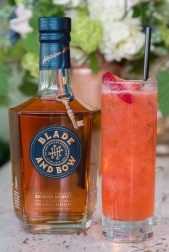Bourbon may be a French word, but it’s an all-American spirit. Sweet, delicious bourbon tastes the way gold looks, and serves as a trusty companion to, well, just about anything. Since a single day can’t sufficiently honor such a divine spirit, this September is National Bourbon Heritage Month.
This isn’t just some arbitrary celebration manufactured by corporate interests — god, no; rather, it’s an arbitrary month-long holiday manufactured by the U.S. Congress in 2007. The resolution creating the holiday was passed by unanimous consent, proving that our lawmakers are capable of agreeing on something.

As with many old and hallowed things, the origin of bourbon is somewhat unclear. Bourbon was likely developed by European settlers of the American frontier (Appalachia) during late 1700s. In a Bourbon Country Reader article, whiskey writer Charles K. Cowdery writes that whiskey-making on the frontier was “as common as baking bread.”
Some claim that a Baptist minister named Elijah Craig made the first Kentucky bourbon in the 1780s, when he opened a distillery in what would become Georgetown, KY. While Craig was a real figure, this is a massaging of the truth perpetuated by anti-temperance folks in the late 19th century (“bourbon can’t be all bad — it was invented by a minister!”).
Related: The Best Old Fashioned Recipe
Bourbon is named after Kentucky’s Bourbon County, the spirit’s widely accepted birthplace. Bourbon County was so named as a tribute to the French, who lent the U.S. a hand during the American Revolution. The spirit swiftly gained popularity and was eventually sold downriver to New Orleans, where the population embraced it as an inexpensive alternative to Cognac. The rest is sweet, golden history.
In 1964, Congress declared bourbon “America’s Native Spirit” and laid down hard and fast rules for what exactly bourbon is and isn’t. Bourbon must be made with at least 51% corn, stored in charred white oak barrels, distilled at less than 160 proof (80% ABV), and have no artificial flavoring. Today, bourbon accounts for at least two-thirds of all U.S. spirit exports.
We could write about bourbon for days, but we’d rather be drinking it. Without further ado, here are some excellent bourbon drink ideas that you might consider sometime this month (and every month after, until the sun explodes).
1. The Anytimer
Ingredients:
- 1.3 oz Bulleit Bourbon
- 1 oz orange juice
- 1 oz. lemon juice
- ½ oz. simple syrup
- ½ oz. amaretto
Directions:
Shake ingredients with ice and strain into an ice-filled glass. Garnish with an orange and cherry.
2. Gramercy Buck
(Created by Amanda Tissue of the Gramercy Park Hotel, NYC)
Ingredients:
- 1.3 oz. Blade and Bow Kentucky Straight Bourbon Whiskey
- 1 oz. lemon juice
- .75 oz. simple syrup
- muddled strawberries
- ginger beer
Directions:
Shake ingredients with ice and strain into a highball glass. Top off with ginger beer.
3. Old Fashioned
Ingredients:
- 1.3 oz. I.W. Harper Kentucky Straight Bourbon Whiskey
- Bar spoon of brown sugar
- Dash of orange bitters
- 2 dashes aromatic bitters
Directions:
Combine ingredients in a tumbler, stir. Garnish with orange twist and cherry.
4. Orphan Barrel Rhetoric 21 Year Old
Ingredients:
Directions:
Enjoy neat or on the rocks






